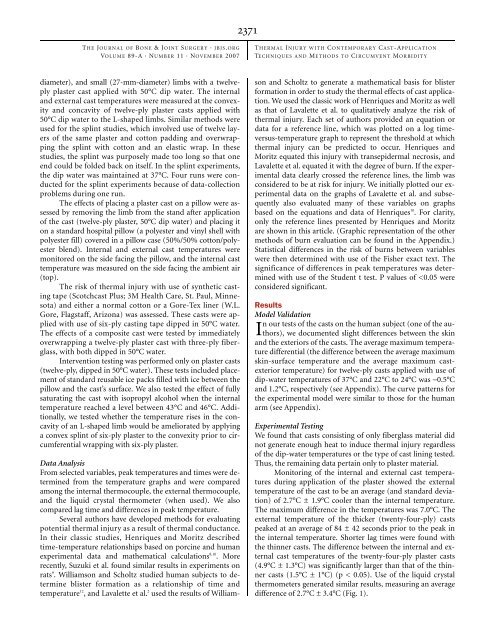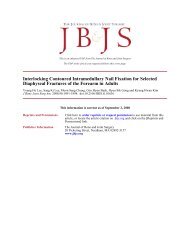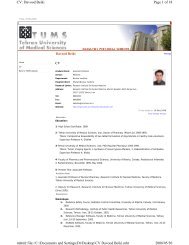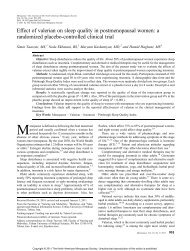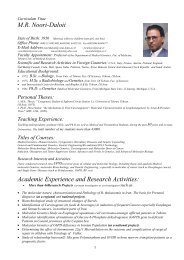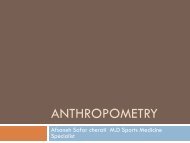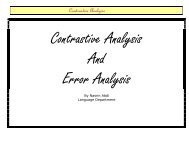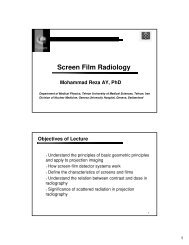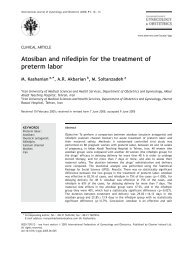Thermal Injury with Contemporary Cast-Application Techniques and ...
Thermal Injury with Contemporary Cast-Application Techniques and ...
Thermal Injury with Contemporary Cast-Application Techniques and ...
You also want an ePaper? Increase the reach of your titles
YUMPU automatically turns print PDFs into web optimized ePapers that Google loves.
THE JOURNAL OF BONE & JOINT SURGERY · JBJS.ORG<br />
VOLUME 89-A · NUMBER 11 · NOVEMBER 2007<br />
diameter), <strong>and</strong> small (27-mm-diameter) limbs <strong>with</strong> a twelveply<br />
plaster cast applied <strong>with</strong> 50°C dip water. The internal<br />
<strong>and</strong> external cast temperatures were measured at the convexity<br />
<strong>and</strong> concavity of twelve-ply plaster casts applied <strong>with</strong><br />
50°C dip water to the L-shaped limbs. Similar methods were<br />
used for the splint studies, which involved use of twelve layers<br />
of the same plaster <strong>and</strong> cotton padding <strong>and</strong> overwrapping<br />
the splint <strong>with</strong> cotton <strong>and</strong> an elastic wrap. In these<br />
studies, the splint was purposely made too long so that one<br />
end could be folded back on itself. In the splint experiments,<br />
the dip water was maintained at 37°C. Four runs were conducted<br />
for the splint experiments because of data-collection<br />
problems during one run.<br />
The effects of placing a plaster cast on a pillow were assessed<br />
by removing the limb from the st<strong>and</strong> after application<br />
of the cast (twelve-ply plaster, 50°C dip water) <strong>and</strong> placing it<br />
on a st<strong>and</strong>ard hospital pillow (a polyester <strong>and</strong> vinyl shell <strong>with</strong><br />
polyester fill) covered in a pillow case (50%/50% cotton/polyester<br />
blend). Internal <strong>and</strong> external cast temperatures were<br />
monitored on the side facing the pillow, <strong>and</strong> the internal cast<br />
temperature was measured on the side facing the ambient air<br />
(top).<br />
The risk of thermal injury <strong>with</strong> use of synthetic casting<br />
tape (Scotchcast Plus; 3M Health Care, St. Paul, Minnesota)<br />
<strong>and</strong> either a normal cotton or a Gore-Tex liner (W.L.<br />
Gore, Flagstaff, Arizona) was assessed. These casts were applied<br />
<strong>with</strong> use of six-ply casting tape dipped in 50°C water.<br />
The effects of a composite cast were tested by immediately<br />
overwrapping a twelve-ply plaster cast <strong>with</strong> three-ply fiberglass,<br />
<strong>with</strong> both dipped in 50°C water.<br />
Intervention testing was performed only on plaster casts<br />
(twelve-ply, dipped in 50°C water). These tests included placement<br />
of st<strong>and</strong>ard reusable ice packs filled <strong>with</strong> ice between the<br />
pillow <strong>and</strong> the cast’s surface. We also tested the effect of fully<br />
saturating the cast <strong>with</strong> isopropyl alcohol when the internal<br />
temperature reached a level between 43°C <strong>and</strong> 46°C. Additionally,<br />
we tested whether the temperature rises in the concavity<br />
of an L-shaped limb would be ameliorated by applying<br />
a convex splint of six-ply plaster to the convexity prior to circumferential<br />
wrapping <strong>with</strong> six-ply plaster.<br />
Data Analysis<br />
From selected variables, peak temperatures <strong>and</strong> times were determined<br />
from the temperature graphs <strong>and</strong> were compared<br />
among the internal thermocouple, the external thermocouple,<br />
<strong>and</strong> the liquid crystal thermometer (when used). We also<br />
compared lag time <strong>and</strong> differences in peak temperature.<br />
Several authors have developed methods for evaluating<br />
potential thermal injury as a result of thermal conductance.<br />
In their classic studies, Henriques <strong>and</strong> Moritz described<br />
time-temperature relationships based on porcine <strong>and</strong> human<br />
experimental data <strong>and</strong> mathematical calculations 8,10 . More<br />
recently, Suzuki et al. found similar results in experiments on<br />
rats 9 . Williamson <strong>and</strong> Scholtz studied human subjects to determine<br />
blister formation as a relationship of time <strong>and</strong><br />
temperature 12 , <strong>and</strong> Lavalette et al. 2 used the results of William-<br />
2371<br />
T HERMAL INJURY WITH CONTEMPORARY CAST-APPLICATION<br />
TECHNIQUES AND METHODS TO CIRCUMVENT MORBIDITY<br />
son <strong>and</strong> Scholtz to generate a mathematical basis for blister<br />
formation in order to study the thermal effects of cast application.<br />
We used the classic work of Henriques <strong>and</strong> Moritz as well<br />
as that of Lavalette et al. to qualitatively analyze the risk of<br />
thermal injury. Each set of authors provided an equation or<br />
data for a reference line, which was plotted on a log timeversus-temperature<br />
graph to represent the threshold at which<br />
thermal injury can be predicted to occur. Henriques <strong>and</strong><br />
Moritz equated this injury <strong>with</strong> transepidermal necrosis, <strong>and</strong><br />
Lavalette et al. equated it <strong>with</strong> the degree of burn. If the experimental<br />
data clearly crossed the reference lines, the limb was<br />
considered to be at risk for injury. We initially plotted our experimental<br />
data on the graphs of Lavalette et al. <strong>and</strong> subsequently<br />
also evaluated many of these variables on graphs<br />
based on the equations <strong>and</strong> data of Henriques 10 . For clarity,<br />
only the reference lines presented by Henriques <strong>and</strong> Moritz<br />
are shown in this article. (Graphic representation of the other<br />
methods of burn evaluation can be found in the Appendix.)<br />
Statistical differences in the risk of burns between variables<br />
were then determined <strong>with</strong> use of the Fisher exact text. The<br />
significance of differences in peak temperatures was determined<br />
<strong>with</strong> use of the Student t test. P values of


